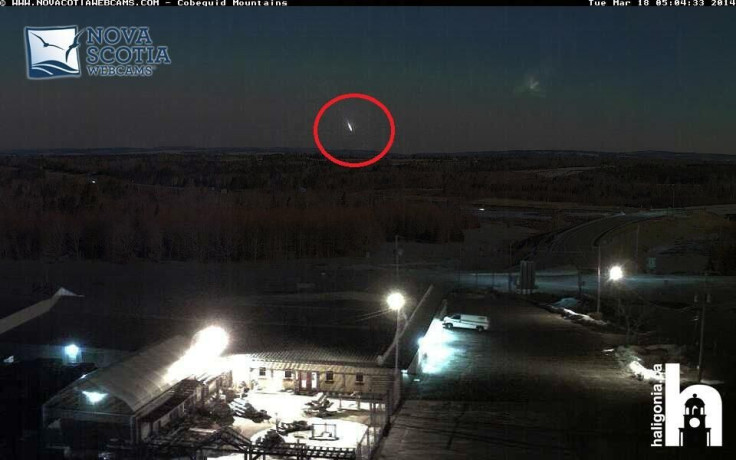Giant ‘Fireball’ Seen Over Canadian Maritimes, Looked Like ‘The Sun Was Dropping Out Of The Sky’ [VIDEO]

A bright light that resembled a fireball was spotted in the sky over the Canadian provinces of Nova Scotia and Quebec early Tuesday morning.
Astronomers say the bright light that was spotted between 4 and 5 a.m. on Tuesday was most likely a space rock that hit the atmosphere and disintegrated. Witnesses say the fireball was so bright it lit up the sky.
“It was a bright light and it lit up the whole sky, and when I looked out the window, I just saw what appeared to be maybe the tail end of it, if you like, and it was almost like a meteor but not the same," Rick Parker, who lives on Mattatall Lake near Wentworth, Nova Scotia, told the Canadian Broadcast Corporation. "It was falling in the northern horizon.”
Early morning news reports and social media were flooded with reports of a bright light in the sky. Some described seeing red flames another man said it looked like a multicolored, white, orange and green teardrop-shaped light. While some thought the light could have been caused by the International Space Station that was passing by the region at the time, astronomers say it was most likely space junk.
“This was much, much brighter. It started as a bright light. It lit up the sky enough to make me look out. I was just lying in bed, thinking about a fire in the wood stove, actually, and it lit up the whole sky. I mean it was very bright,” Parker said.
Astronomy professor Rob Thacker agrees.
“There is lots of this stuff floating around [in space],” Thacker told the Globe and Mail. “These things happen reasonably frequently … once every two years.”
Thacker tracked the fireball using social media and believed it started in Boston and traveled along the East Coast before dissolving above Quebec. This isn’t the first fireball reported in Canada this month.
A fireball was spotted over Canada’s Yukon Territory on March 7. The explosion was caught on camera by a photographer leading a tour in the area.
“It got so bright that I had to close my eyes like someone used electric flash in front of me. A few minutes later, we could hear the huge explosion from the direction of the fireball fell. What an exciting night!!!” photographer Yuichi Takasaka described next to photos posted on spaceweathergallery.com.
Unlike the fireball in Canada’s Arctic region, the latest one emitted a sonic boom which may mean it was closer to the ground than expected, Thacker said. But there has yet to be reports of debris on the ground, he adds.
Astronomer David Lane, director of the observatory at Saint Mary's University in Halifax, said the fireball may have been sizeable.
“It’s really hard to tell but venturing a guess, we’re not talking about something really big, probably something maybe the size of a car or something like that,” he told the CBC adding that it is equally as difficult to find out exactly where the space object landed.
“It’s almost analogous to the search going on now for that airplane in Asia. You know, having one or two points of radio contact is not enough to triangulate where it actually is,” he said.
Fireballs, which are exceptionally bright meteors, are rarely visible from Earth. But for a few weeks each year around the March equinox, fireball sightings can increase in prevalence by 30 percent, according to NASA. While the reason for this has yet to be confirmed, the space agency theorizes that more space debris “litters this section of Earth’s orbit.” Since meteors are debris from space, as they near Earth’s atmosphere some may vaporize while others penetrate, giving humans to see a spectacular show in the sky.
Morris McIntyre, from Charlottetown, Nova Scotia, remains baffled from what he saw on Tuesday morning.
“It was just this great big orange ball. It was like the sun was dropping out of the sky,” he said.
© Copyright IBTimes 2025. All rights reserved.




















